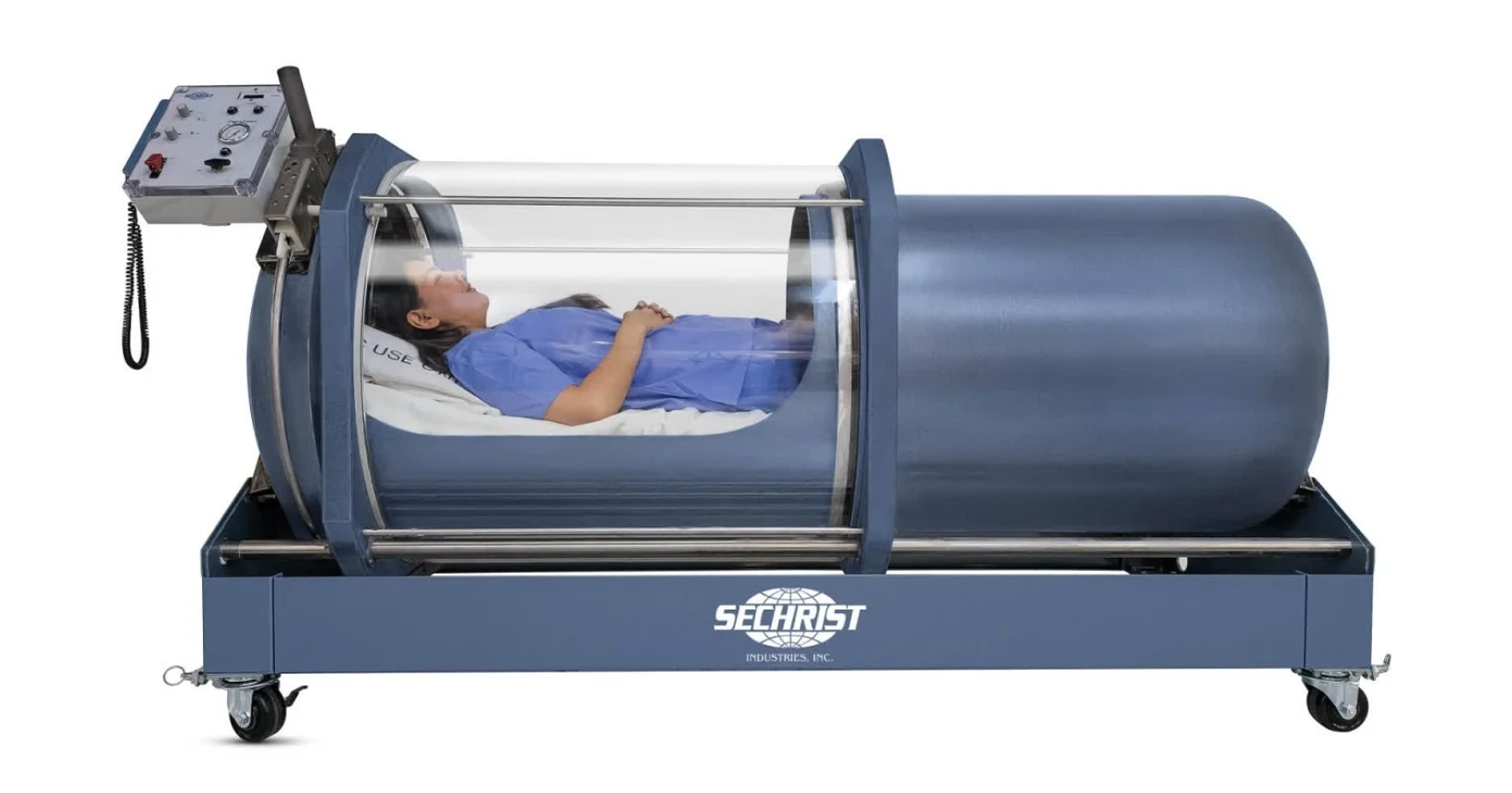
Brain HBOT
Coming 2025
Take a dive.
Diving Depth
Your brain is a superpower, and it needs oxygen. Although the brain makes up less than 5% of the body's mass, it uses over 20% of our oxygen intake. Age depletes our oxygen-delivering capacity and degrades our minds. Neurodegeneration doesn't have to be the norm. Your brain can heal.
Hyperbaric oxygen therapy involves breathing up to 100 percent oxygen in a pressurized chamber. Based on laws of physics – Boyle's, Henry's, and Dalton's Law – breathing oxygen under pressure allows oxygen to dissolve into blood plasma. Under normal conditions, hemoglobin in red blood cells carries oxygen. Dissolving oxygen into plasma allows oxygen to penetrate deep into the brain’s tissues, including the lymphatics and the cerebrospinal fluid surrounding the brain and spinal cord.
But why would you want to increase the oxygen concentration in your brain?
Rescue cells at risk of dying.
Constrict blood vessels to reduce fluid leakage and swelling. Inflammation is a critical factor in why our brains degrade with time.
Increase antioxidants and free radical scavengers to fight infection.
Grow blood vessel, allowing revitalized tissue to thrive.
Increase stem cell numbers by eightfold. Stem cells can differentiate into any tissue, including neurons, allowing regeneration.
Enable mitochondria, the cell’s powerhouse, to generate the brain’s primary energy source called adenosine triphosphate.
Frequently asked questions
What is Hyperbaric Oxygen Therapy?
Hyperbaric Oxygen Therapy (HBOT) is a medical treatment in which an individual is entirely enclosed in a pressure chamber, breathing 100% pure oxygen at greater than one atmosphere pressure. Air contains nearly 21% oxygen and approximately 78% nitrogen. In hyperbaric oxygen therapy, the oxygen percentage breathed by the patient is almost 100%, nearly five times more than in air. The pressure of the oxygen an individual breathes in a hyperbaric oxygen chamber is usually more than 1.5 to 3 times greater than atmospheric pressure. HBOT can deliver nearly 15 times as much oxygen as air at normal pressure.
How does hyperbaric oxygen work?
Hyperbaric oxygen therapy dramatically increases the amount of oxygen delivered to body tissues by your blood. It is important to note that the benefits of hyperbaric oxygen therapy result from an oxygen-enriched bloodstream and not from the oxygen’s direct contact with wounds. This is why wound dressings are usually left in place during treatment. This treatment provides one or more of the following effects:
Enhanced wound healing
Increased oxygen delivery to injured tissue
Improved infection control
Greater blood vessel formation
Preservation of damaged tissues
Elimination and reduced effects of toxic substances
Reduction or elimination of gas-bubble obstructions
What are the physiological actions caused by hyperbaric oxygen that make it work?
Hyperoxygenation: HBOT physically dissolves extra oxygen into the blood plasma, which is then delivered to the tissues. Breathing pure oxygen at two to three times normal pressure provides 10 to 15 times as much physically dissolved oxygen to tissues. This can increase the tissue oxygen in compromised tissues to greater-than-normal values. Hyperoxygenation has been demonstrated to induce the formation of new capillaries in ischemic or poorly perfused wounds. Therefore, it is helpful in the treatment of ischemic-based compromised wounds, flaps, and grafts. It also treats some infections by allowing white cell (leukocytic) activity to resume function.
Mechanical Effect of Increased Pressure: Any gas in the body will decrease in volume as the pressure increases. With a threefold increase in pressure, a bubble trapped in the body is reduced by two-thirds. Thus, reducing gas volume resolves air embolism and decompression illness when the diagnosis to treatment is prompt.
Vasoconstriction: High-pressure oxygen causes constriction of the blood vessels in normal tissues without creating hypoxia. It does not cause constriction in previously oxygen-deprived tissues. The vasoconstriction decreases edema, which is helpful in the treatment of burns, crush injuries, compartment syndromes, and other acute traumatic ischemias. Even though the blood flow contributing to edema is reduced, oxygen delivery to the tissues is maintained through hyperoxygenation.
Antimicrobial Activity: HBOT inhibits alpha toxin production, as seen in anaerobic infections such as Clostridium Perfringens. The most common cause of gas gangrene is clostridium perfringens; however, several gas-producing organisms (aerobic and anaerobic) require surgical debridement initially. It also enhances the white cell killing activity, which provides an excellent adjuvant to antibiotic and local wound care.
Mass Action of Gases: The flooding of the body with any one gas tends to wash out others. This action occurs more rapidly under pressure than in ordinary conditions, making HBOT an indicated treatment for decompression sickness.
Reduction of Reperfusion Injury: Following an ischemic interval, indirect injury occurs, mediated by the inappropriate activation of leukocytes. HBOT prevents such activation. Adherence of white blood cells to capillary walls is markedly reduced, thus mitigating the “no-reflow” phenomenon. This is why HBOT therapy is indicated in carbon monoxide poisoning and is considered the treatment of choice.
What are the clinically accepted indications for Hyperbaric Oxygen Therapy?
The Undersea and Hyperbaric Medicine Society has approved HOBT for the following indications:
Air or Gas Embolism
Carbon Monoxide Poisoning Carbon Monoxide Poisoning Complicated by Cyanide Poisoning
Clostridial Myositis and Myonecrosis (i.e., Gas Gangrene)
Crush Injury, Compartment Syndrome, and other Acute Traumatic Ischemias
Decompression Sickness
Enhancement of Healing in Selected Problem Wounds; Arterial Insufficiencies; Central Retinal Artery Occlusion
Severe Anemia
Intracranial Abscess
Necrotizing Soft Tissue Infections
Refractory Osteomyelitis
Delayed Radiation Injury (i.e., Soft Tissue and Bony Necrosis)
Compromised Skin Grafts and Flaps
Acute Thermal Burn Injury
The Food and Drug Administration has approved the following indications for use appropriate to the primary or adjunctive use of hyperbaric oxygen). The disorders on the list have been scientifically validated and verified through extensive data collection.
Air or Gas Embolism
Carbon Monoxide Poisoning, Carbon Monoxide Poisoning Complicated by Cyanide Poisoning
Clostridial Myositis and Myonecrosis (i.e., Gas Gangrene)
Crush Injury, Compartment Syndrome, and other Acute Traumatic Ischemias
Decompression Sickness
Enhancement of Healing in Selected Problem Wounds
Severe Anemia
Necrotizing Soft Tissue Infections
Refractory Osteomyelitis
Delayed Radiation Injury (i.e., Soft Tissue and Bony Necrosis)
Compromised Skin Grafts & Flaps
In addition, Medicare coverage determinations will reimburse in the U.S. for the following conditions:
An individual has Type I or type II diabetes and has a lower extremity wound that is due to diabetes;
An individual has a wound classified as Wagner grade III or higher
An individual has failed an adequate course of standard wound therapy.
Acute Thermal Burn Injury
Are researchers studying other conditions to treat with hyperbaric oxygen?
Hyperbaric oxygen therapy is undergoing clinical research for several psychiatric, neurological, and systemic conditions as exampled below:
Anoxic Brain Injury
Arthritis
Cerebral Palsy
Chronic Fatigue Syndrome
Chronic Pain
Complex Regional Pain Syndrome
Traumatic Brain Injury
Crohn’s Disease
Fibromyalgia
Inflammatory Bowel Disease
Interstitial Cystitis
Lyme Disease
Migraine
Multiple Sclerosis
Spinal Cord Injuries
Sports Injuries
Stroke
Ulcerative Colitis
Post Traumatic Stress Disorder
Autism
Trigeminal Neuralgia
Osteoradionecrosis
Diabetes Mellitus
Chronic Ulcers of the Lower Limbs
Radiation Injuries
Periodontal Disease
Anoxia
White Matter Hyperintensities
Retinitis Pigmentosa
How is a hyperbaric treatment administered?
Hyperbaric oxygen therapy is administered in a pressurized chamber. The hyperbaric chamber is a steel, aluminum, or clear plastic room where air can be compressed to a pressure greater than sea level. There are basically two types of chambers, monoplace and multiplace.
Monoplace Chambers: A monoplace chamber is a system that accommodates one person at a time. An individual lies down on a stretcher, which slides into the chamber. Typically, the chamber is pressurized with 100% oxygen. The patient receives 100% oxygen by breathing the oxygen inside the chamber. A mask or a hood is not needed. Monoplace chambers can be pressurized up to 3 ATA. Other than decompression sickness and gas embolism, the UHMS protocols for hyperbaric therapy do not require greater than 3 ATA of pressure for treatment. Critically ill patients requiring extensive life support equipment can be treated in the Sechrist monoplace. The vast majority of hyperbaric therapy chambers are monoplace chambers.
Multiplace Chambers: A multiplace chamber is a system that can accommodate two or more occupants. Depending on the size, an individual can walk or be wheeled (sitting or lying down) into a multiplace chamber. Typically, an attendant is inside with the individual. The chambers are pressurized with compressed air through a dedicated supply system. 100% oxygen is delivered to the individual via a mask or a hood assembly. Multiplace chambers can be pressurized to 6 ATA. Higher pressures may treat decompression sickness and air embolism cases.
How long is a hyperbaric treatment?
The typical treatments are approximately one to two hours long except for decompression sickness and arterial gas embolism. Treatments are administered once or twice a day. In some cases, treatments are administered every eight hours. Most acute conditions are treated in less than ten days. Chronic conditions may require 60 or more treatments.
How many treatments are needed?
An individual's clinical response and other factors dictate the required treatments. Emergency cases like carbon monoxide poisoning, arterial gas embolism, or decompression sickness may only need one or two treatments. Non-healing wounds may call for 30 treatments. Radiation tissue injury may require 60 or more hyperbaric oxygen treatments for optimal benefit.
What does a hyperbaric treatment feel like?
Generally, an individual will feel the same. However, during certain parts of the treatment, when the pressure inside the chamber is gradually increased and decreased, the individual may experience a sensation of fullness in the ears, similar to the feeling experienced on an airplane. This is a result of the eardrum responding to pressure changes. Before treatment, the individual will be taught to clear their ears to avoid discomfort. Inside the chamber, the patient can sleep, watch TV, listen to music, read, or relax.
How does an individual prepare for a hyperbaric treatment?
An individual must wear 100% cotton garments during a treatment. Personal items are not allowed in the hyperbaric chamber. An individual cannot use electrical appliances, jewelry, cosmetics, alcohol or petroleum-based products, pacemakers, implanted pumps, earplugs, or combustible materials such as paper, magazines, and excess bedding in the chamber.
What are possible side effects of hyperbaric treatment?
The most common side effects of HBOT are listed below:
Claustrophobia
Ear popping
Temporary myopia
In rare cases, the lungs become irritated by the oxygen, and the individual develops a dry cough that resolves once the treatment stops. Overall, HBOT is a safe procedure.
Are there standard HBOT protocols?
Hyperbaric oxygen must be administered carefully to avoid toxic effects because oxygen inspired under increased atmospheric pressure is a potent drug. Safe treatment times, dose, and pressure limits have been established for hyperbaric oxygen exposure, and these limitations form the basis for all treatment protocols.
Is the chamber cleaned and disinfected?
The chamber is washed according to the case type being treated. The chamber and mattress surfaces are washed with an approved disinfectant or mild dishwashing soup.


